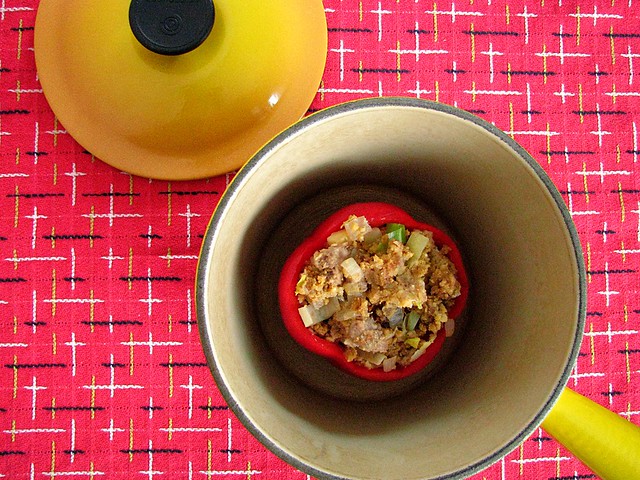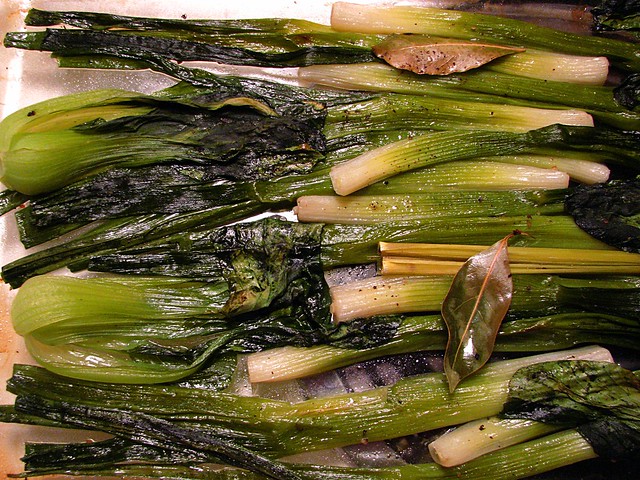It doesn't take much effort for me to get excited about experimentation in my kitchen. I actually found it hard to sleep the other night after the Salt Block cooking class, just imagining what fun I'd have playing around the next day. My first order of business was to get some better looking photos with a full charge on my batteries and some much appreciated sun coming in the dining room window.

That miserable looking spider plant on the right may do well to soak up some much needed light in its new location: I've had it since high school, and this is the final piece.
The first thing I needed to do was bring the Saltware up to temperature slowly. Since this was my first experience, I may have been a bit overly cautious, and waited a full ten minutes from the time I heard the *beep* signaling the increase, before inching up 20 degrees at a time. As I had started at 200 degrees, this seemed to be taking a while. I used my favorite timer, pictured below.

Around 300 degrees, I started to notice that the incremental temperature change seemed to be speeding up. I started to increase by 25 degrees every time I heard the *beep*, and before long, I was finally at the 450 mark. I had formed my small round of bread (from my recipe of stored dough) prior to the oven heat, and made sure to use a small enough amount so it would fit nicely on the 8x8 salt block.

I also took Chef Malavenda's tip of letting the dough rise on parchment, and then sliding it out from under it about 5 minutes after it hit the salt - making sure that the dough was set enough that it wouldn't move. I think the bread turned out fine, but not too noticeably different than the breads I usually cook on a stone. I also noticed the flavor wasn't noticeably different, but I'm wondering if I shouldn't crank the oven up to 500 next time, and try and slide the dough right onto the slab.

It was delicious bread, and because I used no steam in the oven, the crust was nicely chewy. The interior texture was about normal, if not a little more moist, and it was very, very tasty. I even ate some today with butter (something that never happens in the privacy of my own home), after Chef Malavenda said to store unsalted butter on a slab of salt, since it slowly draws out the flavor.

I decided I had to make fried eggs for supper, since I had fresh bread, some local Saxon cheese, and a still warm salt slab. I began my oven heat increments a bit faster, since the block was still fairly warm to the touch, and when I hit 450 degrees I placed the stone stovetop on top of a sheet pan, just in case.
As soon as the salt slab was in place, I poured some extra virgin olive oil, and brushed it around evenly. I knew immediately this was the proper choice for my inaugural egg-frying experience. The fruity, mineraly steam that rose from the salt was intoxicatingly good. I quickly opted for further insurance, and used egg rings until the eggs were just barely set. I wasn't sure just how hot the stone actually was, and was a bit worried that they would run a little too much.

Just a quick sprinkle of Aleppo pepper, and a quick bat of my right hand by my left out of the salt dish... old habits are hard to change! You can kind of see in the above photo how the salt seemed to "crack" under the weight of the oil and eggs - it even seemed to have changed color when the eggs were removed. It is so interesting to see how natural products change as you use them! (It also reminded me of when GOP and I decided to crack an egg onto the black, hot asphalt of the next door bank parking lot one particularly scorching summer's day. It did not work, if you're wondering...)

After the photo, I remembered the cheese!
Perfectly salted fried eggs, with dreamily runny yolks were my reward! I was so excited at the taste of these eggs on their own, I couldn't even bring myself to add my usual hot sauce. I gratefully lapped up all of the yolks off the plate with the help of a bit more bread, and called it a night.
After a few hours, the Saltware was still warm, but cool enough to handle. I gingerly ran it under warm water to clean it, and towel dried it before leaving it to air on a wire rack overnight, again intrigued at the feel of such a mass of salt under warm, running water. I also remembered that in my last post about the Saltware class, I shamefully neglected to mention the
POSH salt founder, Linda Castelli.
She was a Registered Nurse and then a lawyer before finding her passion for salt, and indeed inventing the concept of using the salt to actually cook food, instead of just flavoring the food with the salt. These slabs come in a variety of sizes, and even have been custom fit to line pizza ovens and table side grills of adventuresome restaurants. As long as you are careful, the slabs appear to last a long time, and I can't help but draw the similarity to a human being: resilient and sturdy, yet inelastic and fragile. Perhaps it's due to our own salt content that has increased our in interests in baking salts, cooking salts, finishing salts and now Saltware. Whatever the reason, you can be sure that the hype is very deserved, and that I certainly will be doing a whole lot more experimentation!


















